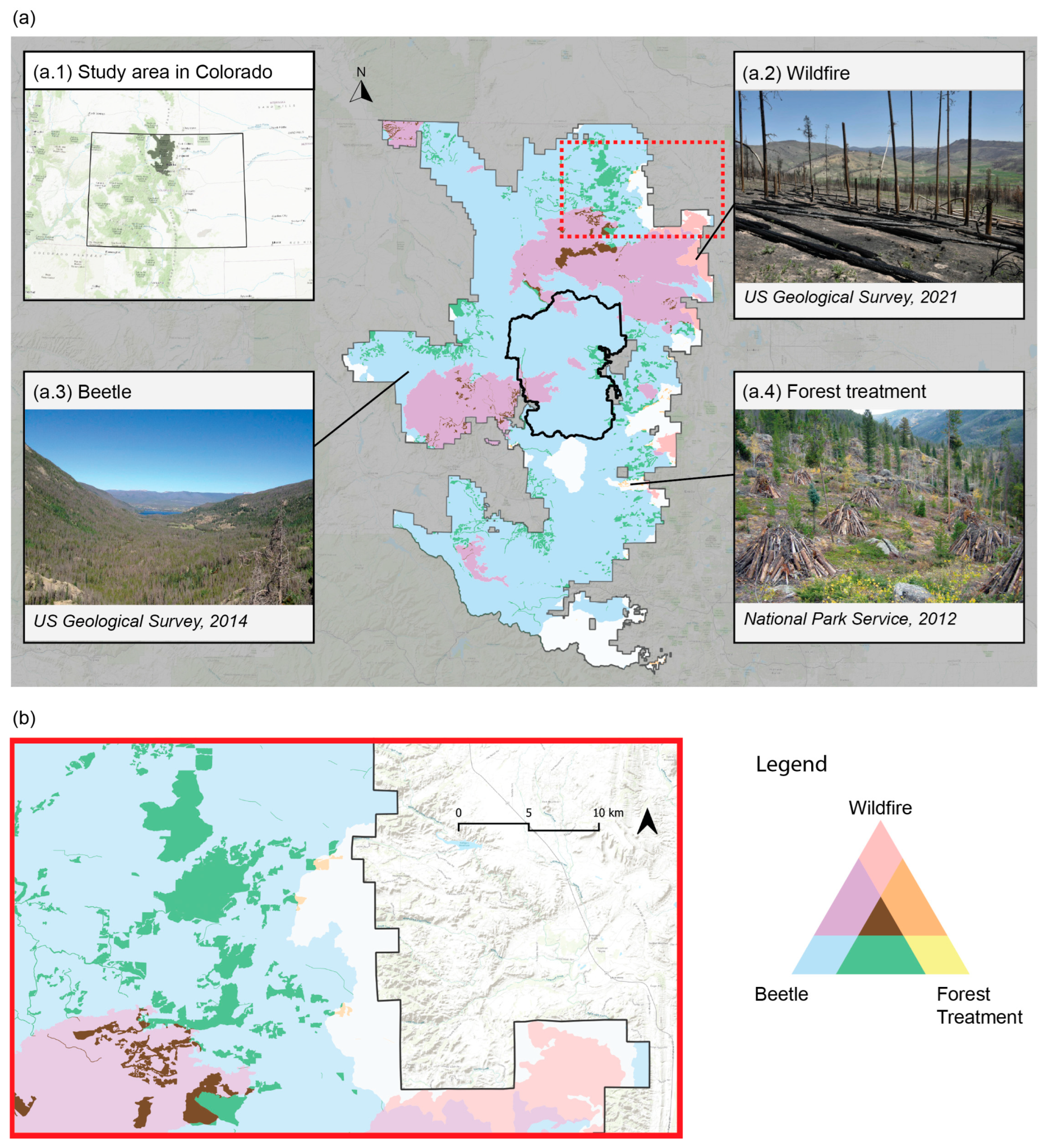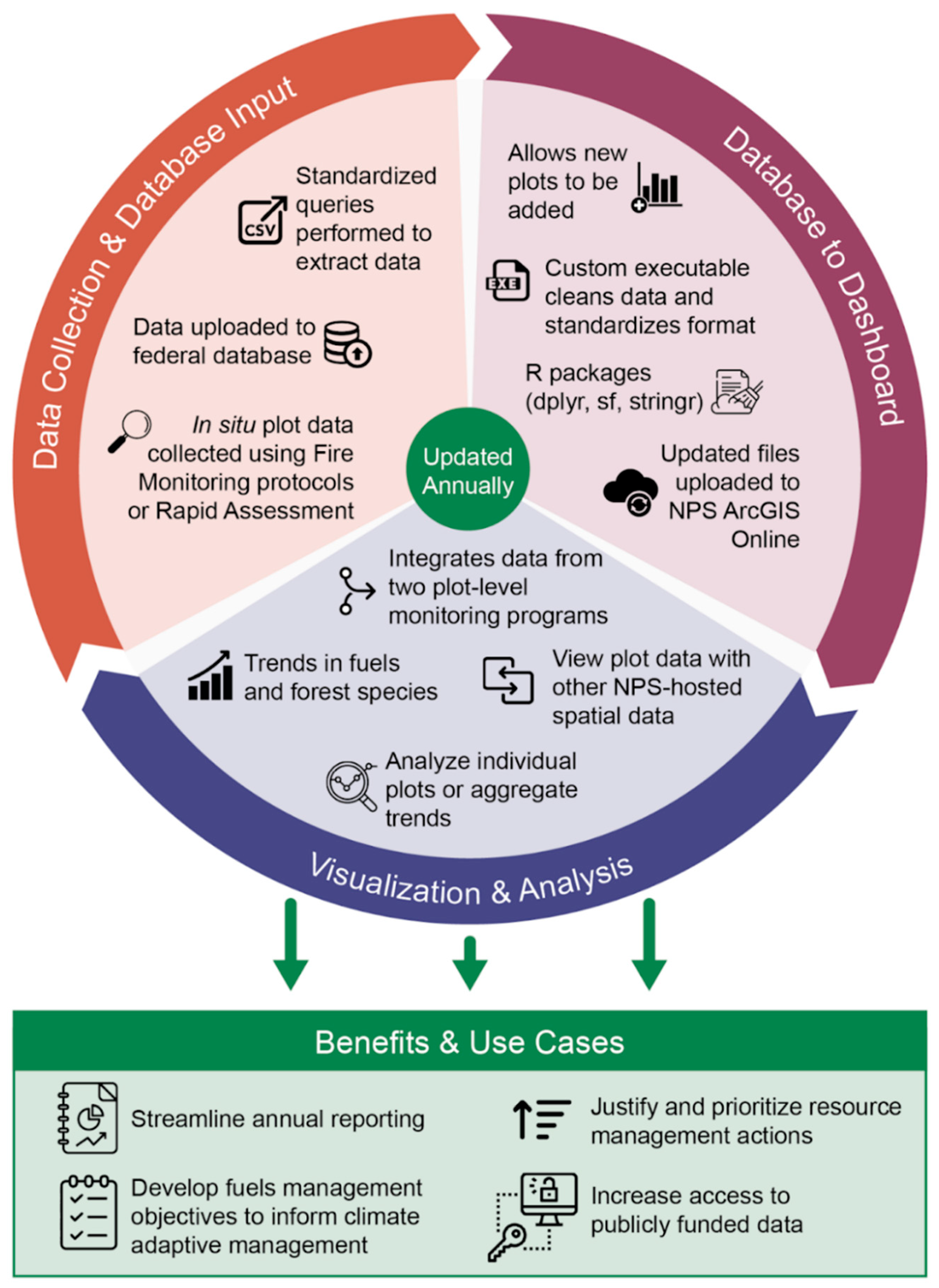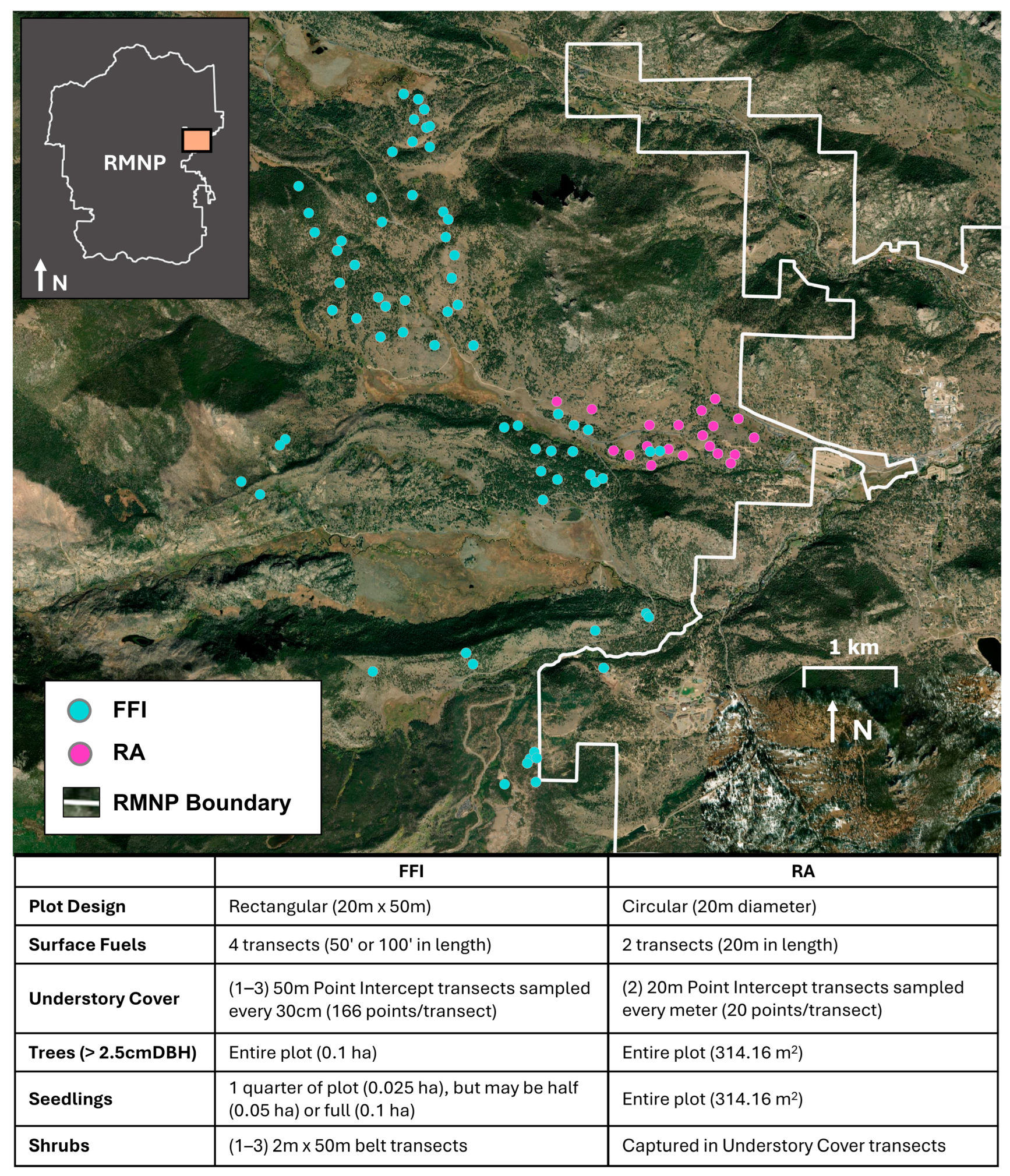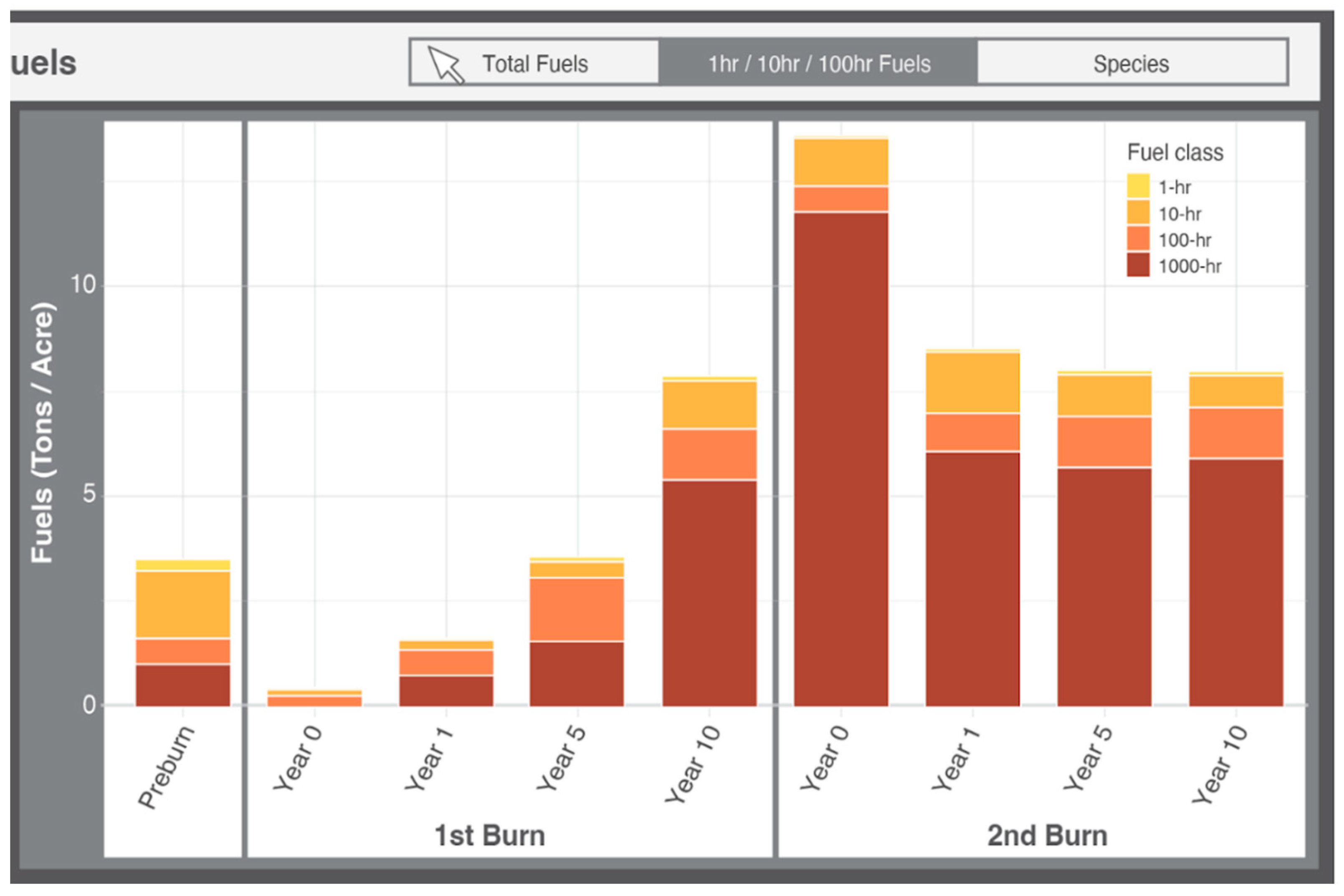Interactive Visualizations of Integrated Long-Term Monitoring Data for Forest and Fuels Management on Public Lands
Abstract
1. Introduction
1.1. Long-Term Monitoring for Adaptive Forest Management
- How effective is a specific treatment in reducing fuel loads and achieving desired vegetation conditions?
- Which plots need initial or additional fuel treatments?
- What type of fuel treatment is required?
- How might fuel treatments interact with climate change to realize different vegetation communities?
1.2. The Colorado Front Range and Rocky Mountain National Park
1.3. Objectives
2. Dashboard Development
2.1. Data Collection and Processing Dashboard Inputs
2.2. Database to Dashboard
2.3. Dashboard Visualizations and Analysis
2.3.1. Total Fuels
2.3.2. Fuel Classes
2.3.3. Species Composition by Forest Vegetation Layer
3. Forest Management with TFFD
3.1. Support for Adaptive Management
3.2. Improvements, Limitations, and Future Use
4. Conclusions
Author Contributions
Funding
Data Availability Statement
Acknowledgments
Conflicts of Interest
References
- Forzieri, G.; Girardello, M.; Ceccherini, G.; Spinoni, J.; Feyen, L.; Hartmann, H.; Beck, P.S.A.; Camps-Valls, G.; Chirici, G.; Mauri, A.; et al. Emergent vulnerability to climate-driven disturbances in European forests. Nat. Commun. 2021, 12, 1081. [Google Scholar] [CrossRef]
- Roshani; Sajjad, H.; Kumar, P.; Masroor, M.; Rahaman, M.H.; Rehman, S.; Ahmed, R.; Sahana, M. Forest Vulnerability to Climate Change: A Review for Future Research Framework. Forests 2022, 13, 917. [Google Scholar] [CrossRef]
- Baker, W.L. Longterm response of disturbance landscapes to human intervention and global change. Landsc. Ecol. 1995, 10, 143–159. [Google Scholar] [CrossRef]
- Blanco, J.A.; Lo, Y.-H.; Kimmins, J.P.; Weber, A. Highlighting Complex Long-Term Succession Pathways in Mixed Forests of the Pacific Northwest: A Markov Chain Modelling Approach. Forests 2021, 12, 1770. [Google Scholar] [CrossRef]
- Aitken, S.N.; Yeaman, S.; Holliday, J.A.; Wang, T.; Curtis-McLane, S. Adaptation, migration or extirpation: Climate change outcomes for tree populations. Evol. Appl. 2008, 1, 95–111. [Google Scholar] [CrossRef]
- Maharjan, S.K.; Sterck, F.J.; Raes, N.; Zhao, Y.; Poorter, L. Climate change induced elevational range shifts of Himalayan tree species. Biotropica 2023, 55, 53–69. [Google Scholar] [CrossRef]
- Benner, J.; Lertzman, K. Policy interventions and competing management paradigms shape the long-term distribution of forest harvesting across the landscape. Proc. Natl. Acad. Sci. USA 2022, 119, e2208360119. [Google Scholar] [CrossRef] [PubMed]
- Augustynczik, A.L.D.; Gusti, M.; Deppermann, A.; Nakhavali, M.A.; Jia, F.; Di Fulvio, F.; Havlík, P. Adapting forest management to climate change impacts and policy targets in the EU: Insights from the coupled GLOBIOM/G4M-i3PGmiX model. One Earth 2025, 8, 101313. [Google Scholar] [CrossRef]
- Murphy, B.A.; Rollinson, C.R.; Dietze, M.C.; Staudhammer, C.L.; VonHedemann, N.R.; Schultz, C.A.; Kleindl, W.J.; Desai, A.R. Insights Into Nature-Based Climate Solutions: Managing Forests for Climate Resilience and Carbon Stability. J. Geophys. Res. Biogeosci. 2025, 130, e2024JG008391. [Google Scholar] [CrossRef]
- Ratajczak, Z.; D’Odorico, P.; Collins, S.L.; Bestelmeyer, B.T.; Isbell, F.I.; Nippert, J.B. The interactive effects of press/pulse intensity and duration on regime shifts at multiple scales. Ecol. Monogr. 2017, 87, 198–218. [Google Scholar] [CrossRef]
- Ren, L.; Yang, Y.; Wang, H.; Wang, P.; Yue, X.; Liao, H. Widespread Wildfires Over the Western United States in 2020 Linked to Emissions Reductions During COVID-19. Geophys. Res. Lett. 2022, 49, e2022GL099308. [Google Scholar] [CrossRef]
- Mitton, J.B.; Ferrenberg, S.M. Mountain Pine Beetle Develops an Unprecedented Summer Generation in Response to Climate Warming. Am. Nat. 2012, 179, E163–E171. [Google Scholar] [CrossRef] [PubMed]
- Herms, D.A.; McCullough, D.G. Emerald Ash Borer Invasion of North America: History, Biology, Ecology, Impacts, and Management. Annu. Rev. Entomol. 2014, 59, 13–30. [Google Scholar] [CrossRef]
- Alexander, J.; Lee, C.A. Lessons Learned from a Decade of Sudden Oak Death in California: Evaluating Local Management. Environ. Manag. 2010, 46, 315–328. [Google Scholar] [CrossRef]
- Harwood, T.D.; Tomlinson, I.; Potter, C.A.; Knight, J.D. Dutch elm disease revisited: Past, present and future management in Great Britain. Plant Pathol. 2011, 60, 545–555. [Google Scholar] [CrossRef]
- Ansari, R.A.; Esimaje, T.; Ibrahim, O.M.; Mulrooney, T. Analysis of Forest Change Detection Induced by Hurricane Helene Using Remote Sensing Data. Forests 2025, 16, 788. [Google Scholar] [CrossRef]
- Turner, M.G.; Baker, W.L.; Peterson, C.J.; Peet, R.K. Factors Influencing Succession: Lessons from Large, Infrequent Natural Disturbances. Ecosystems 1998, 1, 511–523. [Google Scholar] [CrossRef]
- Dale, V.H.; Joyce, L.A.; Mcnulty, S.; Neilson, R.P.; Ayres, M.P.; Flannigan, M.D.; Hanson, P.J.; Irland, L.C.; Lugo, A.E.; Peterson, C.J.; et al. Climate Change and Forest Disturbances. BioScience 2001, 51, 723. [Google Scholar] [CrossRef]
- Brockerhoff, E.G.; Barbaro, L.; Castagneyrol, B.; Forrester, D.I.; Gardiner, B.; González-Olabarria, J.R.; Lyver, P.O.; Meurisse, N.; Oxbrough, A.; Taki, H.; et al. Forest biodiversity, ecosystem functioning and the provision of ecosystem services. Biodivers. Conserv. 2017, 26, 3005–3035. [Google Scholar] [CrossRef]
- Lindenmayer, D.B. Forest Wildlife Management and Conservation. Ann. N. Y. Acad. Sci. 2009, 1162, 284–310. [Google Scholar] [CrossRef]
- Sedjo, R.; Sohngen, B. Carbon Sequestration in Forests and Soils. Annu. Rev. Resour. Econ. 2012, 4, 127–144. [Google Scholar] [CrossRef]
- Bachinger, M.; Mattivi, A.; Hilmer, P.; Karim, A.A. Recreation in Forests: Implications for Tourism Product Development Based on the Analysis of Terpenes in Two Forest Types. In Nature-Based Tourism and Wellbeing; Niccolini, F., Barborak, J.R., Azara, I., Michopoulou, E., Cavicchi, A., Eds.; CABI: Wallingford, UK, 2024; pp. 158–173. ISBN 978-1-80062-139-8. [Google Scholar]
- Tague, C.L.; Moritz, M.; Hanan, E. The changing water cycle: The eco-hydrologic impacts of forest density reduction in Mediterranean (seasonally dry) regions. WIREs Water 2019, 6, e1350. [Google Scholar] [CrossRef]
- Ferretti, M.; Gessler, A.; Cools, N.; Fleck, S.; Guerrieri, R.; Jakovljević, T.; Nicolas, M.; Nieminen, T.M.; Pitar, D.; Potočić, N.; et al. Perspectives: Resilient forests need joint forces for better inventorying and monitoring. For. Ecol. Manag. 2024, 561, 121875. [Google Scholar] [CrossRef]
- Ferretti, M.; Fischer, C.; Gessler, A.; Graham, C.; Meusburger, K.; Abegg, M.; Bebi, P.; Bergamini, A.; Brockerhoff, E.G.; Brunner, I.; et al. Advancing forest inventorying and monitoring. Ann. For. Sci. 2024, 81, 6. [Google Scholar] [CrossRef]
- Lindenmayer, D.B.; Lavery, T.; Scheele, B.C. Why We Need to Invest in Large-Scale, Long-Term Monitoring Programs in Landscape Ecology and Conservation Biology. Curr. Landsc. Ecol. Rep. 2022, 7, 137–146. [Google Scholar] [CrossRef]
- Lindenmayer, D.B.; Likens, G.E. The science and application of ecological monitoring. Biol. Conserv. 2010, 143, 1317–1328. [Google Scholar] [CrossRef]
- Lindenmayer, D.B.; Likens, G.E.; Andersen, A.; Bowman, D.; Bull, C.M.; Burns, E.; Dickman, C.R.; Hoffmann, A.A.; Keith, D.A.; Liddell, M.J.; et al. Value of long-term ecological studies. Austral Ecol. 2012, 37, 745–757. [Google Scholar] [CrossRef]
- Anderson-Teixeira, K.J.; Davies, S.J.; Bennett, A.C.; Gonzalez-Akre, E.B.; Muller-Landau, H.C.; Joseph Wright, S.; Abu Salim, K.; Almeyda Zambrano, A.M.; Alonso, A.; Baltzer, J.L.; et al. CTFS -Forest GEO: A worldwide network monitoring forests in an era of global change. Glob. Change Biol. 2015, 21, 528–549. [Google Scholar] [CrossRef]
- Schuurman, G.W.; Cole, D.N.; Cravens, A.E.; Covington, S.; Crausbay, S.D.; Hoffman, C.H.; Lawrence, D.J.; Magness, D.R.; Morton, J.M.; Nelson, E.A.; et al. Navigating Ecological Transformation: Resist–Accept–Direct as a Path to a New Resource Management Paradigm. BioScience 2022, 72, 16–29. [Google Scholar] [CrossRef]
- Williams, B.K.; Brown, E.D. Managing ecosystems with resist–accept–direct (RAD). Methods Ecol. Evol. 2024, 15, 796–805. [Google Scholar] [CrossRef]
- Bennetts, R.; Chambers, N.; Comiskey, J.; James, K.; Lawler, J.; Legg, K.; Matthews, E.; Mazzu, L.; Ohms, R.; Schreier, C.; et al. Integration of Science and Park Management: A Framework for Partnership; National Park Service: Fort Collins, CO, USA, 2016. [Google Scholar]
- Fancy, S.G.; Bennetts, R.E. Institutionalizing an effective long-term monitoring program in the US National Park Service. In Design and Analysis of Long-Term Ecological Monitoring Studies, 1st ed.; Gitzen, R.A., Millspaugh, J.J., Cooper, A.B., Licht, D.S., Eds.; Cambridge University Press: Cambridge, UK, 2012; pp. 481–497. ISBN 978-0-521-19154-8. [Google Scholar]
- National Park Service. Most Common Vital Signs. 2025. Available online: https://www.nps.gov/im/monitoring.htm (accessed on 16 September 2025).
- USDI National Park Service. Fire Monitoring Handbook; Fire Management Program Center, National Interagency Fire Center: Boise, ID, USA, 2003; p. 274. [Google Scholar]
- Downing, W.M.; Dunn, C.J.; Thompson, M.P.; Caggiano, M.D.; Short, K.C. Human ignitions on private lands drive USFS cross-boundary wildfire transmission and community impacts in the western US. Sci. Rep. 2022, 12, 2624. [Google Scholar] [CrossRef]
- Lovett, G.M.; Burns, D.A.; Driscoll, C.T.; Jenkins, J.C.; Mitchell, M.J.; Rustad, L.; Shanley, J.B.; Likens, G.E.; Haeuber, R. Who needs environmental monitoring? Front. Ecol. Environ. 2007, 5, 253–260. [Google Scholar] [CrossRef]
- Murray, D.L.; Krebs, C.J. Editorial: Long-term monitoring in ecology and evolution: Establishing a sound baseline to help inform our future. Front. Ecol. Evol. 2024, 12, 1469489. [Google Scholar] [CrossRef]
- Lindenmayer, D. Why is long-term ecological research and monitoring so hard to do? (And what can be done about it). Aust. Zool. 2018, 39, 576–580. [Google Scholar] [CrossRef]
- Ramachandran, R.; Bugbee, K.; Murphy, K. From Open Data to Open Science. Earth Space Sci. 2021, 8, e2020EA001562. [Google Scholar] [CrossRef]
- McCord, S.E.; Pilliod, D.S. Adaptive monitoring in support of adaptive management in rangelands. Rangelands 2022, 44, 1–7. [Google Scholar] [CrossRef]
- Schoennagel, T.; Veblen, T.T.; Romme, W.H. The Interaction of Fire, Fuels, and Climate across Rocky Mountain Forests. BioScience 2004, 54, 661. [Google Scholar] [CrossRef]
- Daly, C.; Halbleib, M.; Smith, J.I.; Gibson, W.P.; Doggett, M.K.; Taylor, G.H.; Curtis, J.; Pasteris, P.P. Physiographically sensitive mapping of climatological temperature and precipitation across the conterminous United States. Int. J. Climatol. 2008, 28, 2031–2064. [Google Scholar] [CrossRef]
- National Park Service. Summary of Visitor Use By Month and Year (1979–Last Calendar Year), Integrated Resource Management Applications. 2025. Available online: https://irma.nps.gov/Stats/SSRSReports/Park%20Specific%20Reports/Overnight%20Stays%20(1979%20-%20Last%20Calendar%20Year)?Park=ROMO (accessed on 10 August 2025).
- Radeloff, V.C.; Helmers, D.P.; Mockrin, M.H.; Carlson, A.R.; Hawbaker, T.J.; Martinuzzi, S. The 1990–2020 Wildland-Urban Interface of the Conterminous United States—Geospatial Data, 4th ed.; Forest Service Research Data Archive: Fort Collins, CO, USA, 2022. [Google Scholar] [CrossRef]
- Cumming, G.S.; Cumming, D.H.M.; Redman, C.L. Scale Mismatches in Social-Ecological Systems: Causes, Consequences, and Solutions. Ecol. Soc. 2006, 11, art14. [Google Scholar] [CrossRef]
- National Park Service. State of the Park Report for Rocky Mountain National Park; National Park Service: Washington, DC, USA, 2017. [Google Scholar]
- Wickham, H.; François, R.; Henry, L.; Müller, K.; Vaughan, D. dplyr: A Grammar of Data Manipulation. 2023. Available online: https://CRAN.R-project.org/package=dplyr (accessed on 9 September 2025).
- Wickham, H. stringr: Simple, Consistent Wrappers for Common String Operations. 2023. Available online: https://CRAN.R-project.org/package=stringr (accessed on 9 September 2025).
- Pebesma, E.; Bivand, R. Spatial Data Science: With Applications in R; Chapman and Hall/CRC: Boca Raton, FL, USA, 2023. [Google Scholar] [CrossRef]
- Hagmann, R.K.; Franklin, J.F.; Johnson, K.N. Historical structure and composition of ponderosa pine and mixed-conifer forests in south-central Oregon. For. Ecol. Manag. 2013, 304, 492–504. [Google Scholar] [CrossRef]
- Stephens, S.L.; Lydersen, J.M.; Collins, B.M.; Fry, D.L.; Meyer, M.D. Historical and current landscape-scale ponderosa pine and mixed conifer forest structure in the Southern Sierra Nevada. Ecosphere 2015, 6, 1–63. [Google Scholar] [CrossRef]
- Simard, M.; Romme, W.H.; Griffin, J.M.; Turner, M.G. Do mountain pine beetle outbreaks change the probability of active crown fire in lodgepole pine forests? Ecol. Monogr. 2011, 81, 3–24. [Google Scholar] [CrossRef]
- Picotte, J.J.; Cansler, C.A.; Kolden, C.A.; Lutz, J.A.; Key, C.; Benson, N.C.; Robertson, K.M. Determination of burn severity models ranging from regional to national scales for the conterminous United States. Remote Sens. Environ. 2021, 263, 112569. [Google Scholar] [CrossRef]
- Ross, C.W.; Loudermilk, E.L.; Flanagan, S.A.; Snitker, G.; Hiers, J.K.; O’Brien, J.J. Wildfire Severity Reduction Through Prescribed Burning in the Southeastern United States. Sustainability 2025, 17, 6230. [Google Scholar] [CrossRef]
- Willliams, B.K.; Szaro, R.C.; Shapiro, C.D. Adaptive Management: The U.S. Department of the Interior Technical Guide; Adaptive Management Working Group; U.S. Department of the Interior: Washington, DC, USA, 2009. [Google Scholar]
- Hutto, R.L.; Belote, R.T. Distinguishing four types of monitoring based on the questions they address. For. Ecol. Manag. 2013, 289, 183–189. [Google Scholar] [CrossRef]
- Gray, A.; Brandeis, T.; Shaw, J.; McWilliams, W.; Miles, P. Forest Inventory and Analysis Database of the United States of America (FIA). Biodivers. Ecol. 2012, 4, 225–231. [Google Scholar] [CrossRef]
- Aplet, G.H.; Mckinley, P.S. A portfolio approach to managing ecological risks of global change. Ecosyst. Health Sustain. 2017, 3, e01261. [Google Scholar] [CrossRef]
- Morici, K.M.; Wolk, B.H.; Cheng, A.S.; Cannon, J.B.; Williams, E.C.; Caggiano, M.D.; Brown, H.; Hoffman, C.M. Colorado Wildfire Risk Reduction Grant Final Report; Colorado Forest Restoration Institute, Colorado State University: Fort Collins, CO, USA, 2019; p. 23. [Google Scholar]
- ESRI Introduction to ArcGIS Data Pipelines. ArcGIS Data Pipelines. 2025. Available online: https://doc.arcgis.com/en/data-pipelines/latest/get-started/about-data-pipelines.htm (accessed on 10 August 2025).






Disclaimer/Publisher’s Note: The statements, opinions and data contained in all publications are solely those of the individual author(s) and contributor(s) and not of MDPI and/or the editor(s). MDPI and/or the editor(s) disclaim responsibility for any injury to people or property resulting from any ideas, methods, instructions or products referred to in the content. |
© 2025 by the authors. Licensee MDPI, Basel, Switzerland. This article is an open access article distributed under the terms and conditions of the Creative Commons Attribution (CC BY) license (https://creativecommons.org/licenses/by/4.0/).
Share and Cite
Jones, K.; Vukomanovic, J. Interactive Visualizations of Integrated Long-Term Monitoring Data for Forest and Fuels Management on Public Lands. Forests 2025, 16, 1706. https://doi.org/10.3390/f16111706
Jones K, Vukomanovic J. Interactive Visualizations of Integrated Long-Term Monitoring Data for Forest and Fuels Management on Public Lands. Forests. 2025; 16(11):1706. https://doi.org/10.3390/f16111706
Chicago/Turabian StyleJones, Kate, and Jelena Vukomanovic. 2025. "Interactive Visualizations of Integrated Long-Term Monitoring Data for Forest and Fuels Management on Public Lands" Forests 16, no. 11: 1706. https://doi.org/10.3390/f16111706
APA StyleJones, K., & Vukomanovic, J. (2025). Interactive Visualizations of Integrated Long-Term Monitoring Data for Forest and Fuels Management on Public Lands. Forests, 16(11), 1706. https://doi.org/10.3390/f16111706





